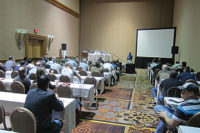As the lingering recession finally eases, attendees at the various industry “Fabricator Forums” are once again focusing on technical issues they face in the shop as well as the field. This was the case at the forum that was held at the last StonExpo/Marmomacc Americas, as attendees discussed countertop installation issues with a panel of industry veterans. The panel featured the following seasoned professionals:
• Scott Lardner, Rocky Mountain Stone, Albuquerque, NM (moderator)
• Rafael Bernal, Great Lakes Granite & Marble Co., Redford, MI
• Rejeana Ellis, Rocky Tops, Greensboro, NC
• Ron Hannah, Cadenza Granite & Marble, Inc., Concord, NC
What are some of the current issues that shops are having with seaming?
Hannah: The goal is to end up with pieces that are “perfectly true.” If you achieve that, the color of the adhesive is less important. But you must also understand that the stone may not lay flat and might need top polishing.
For top polishing, we generally charge $175 per seam, but when a seam is dressed properly, it is often not needed. We have had a number of cases where the customer called during the installation and said, “Forget the top polishing.”
But if I have to top polish because of lippage, then we don’t charge. We explain that all slabs are not perfectly flat, and then we try and keep the lippage towards the back of the seam.
Why are installers using epoxy at the seams? Shouldn’t the seam be where you want the countertop to give?
Hannah: My seams are the weakest point, even though they are very tight. We use a modified acrylic as an adhesive, and if there is settling, the seam will give. We use a chemical biscuit, but not a washer. If the seam lets go, it is doing what it is supposed to do.
Lardner: Changes in humidity are also a factor, especially for us working in a high desert environment. The tolerance between the stone and wall is because the wall moves, not the stone.
Audience Member: We have the same issue in Alberta, Canada, due to the cold environment.
Ellis: We use an 8-foot level on our cabinets to make sure there are no issues, and we use 100% silicone to glue the countertops to the cabinets. We use a knife-grade polyester if they are shimmed a lot.
Are you templating with the existing countertops still in place?
Bernal: If you do that, you cannot see how the cabinets are set, and you need to communicate that to the customer.
Ellis: When we are doing our demo work, guys will often notice support and level issues. That’s why we need to do this a few days in advance of fabrication. We need to see what is there.
Hannah: The template guy needs to take the time to ascertain the job conditions even if the old countertops are in place. You start with the cabinets and design the countertops to suit.
Audience Member: When we run into that, we have our clients sign a waiver that states that the measurements took place before the old tops were removed, and that level cabinets could not be confirmed.
Lardner: We install a sink with a laminate first, so the customer has a working kitchen after demo.
What are your thoughts on leveling the cabinets on your own? It seems that some are doing it for a fee, and others are saying, “Don’t nickel and dime it. Just get it done and get out.”
Bernal: It depends on the price of the job. Can you afford to be leveling cabinets for free?
Hannah: I can tell you one thing: We don’t knock money off the invoice if there is a problem; we fix it. Even if you knock something off the price, the customer was ultimately not happy with the quality of the work, and your reputation will still be sitting there on that countertop.
How do you walk the line of telling the customer what they are responsible for in terms of prep work — cooktops, etc.?
Bernal: Education is the key. We have a list of exactly what the customer needs to do to prepare the site. We even explain to them that the driveway needs to be clean, clear and salted in the winter.
Ellis: You have to make sure this is explained to everyone, including the sales staff. We had a case where someone moved the refrigerator and was responsible for the linoleum floor.
Hannah: It is also important that the salespeople and templater actually reads the preparation requirements to the homeowner. Don’t just expect the homeowner to read them on their own.
What are some ways to make your installations better than the competition?
Hannah: Seams are an opportunity for upsell. We show customers the top-polished seams in our shop, and it eases their concerns. You want to establish a high benchmark, show your quality, and separate yourself from the hacks.
Bernal: Another service is to utilize software to preview the cuts. This is particularly effective with heavily veined material.
Hannah: If you’re matching veins, and you explain what you’re doing, you separate yourself from the competition.
Is anyone placing their seams at the center of the sink cut-out?
Hannah: Never.
Ellis: We don’t do that either.
Audience Member: That’s right where your customer will be standing. You don’t want them staring at the seam.
How do you maintain your integrity with loss leaders at $27/foot?
Ellis: For us, referrals are a large part of our business.
Audience Member: That’s simply a different package. You offer no advance layout, no shop ticket and no customer input for the seams. So you have a single-slab kitchen for $2,300 to $2,400 with no tear-out. The job is done within a 20-mile radius of the shop, and you offer one flat-polished edge.
Bernal: You need to have someone do your job costing. Make sure you know your numbers and are comfortable with them.
Hannah: It is important to know that this is a business first and a passion second. If your business is not making money, then it is a hobby.
Audience Member: We keep track of our cutter production by square foot, and we track our laminator and fabricator production by lineal foot.
Hannah: That’s a great way to have something to measure against; to have something to hold people to.



